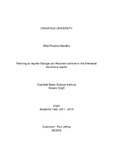JavaScript is disabled for your browser. Some features of this site may not work without it.
| dc.contributor.advisor | Jeffrey, Paul | |
| dc.contributor.author | Pindoria-Nandha, Mital | |
| dc.date.accessioned | 2017-01-19T15:35:23Z | |
| dc.date.available | 2017-01-19T15:35:23Z | |
| dc.date.issued | 2016-06 | |
| dc.identifier.uri | http://dspace.lib.cranfield.ac.uk/handle/1826/11313 | |
| dc.description.abstract | Aquifer Storage and Recovery (ASR) involves the injection of water into an aquifer for subsequent recovery from the same well. Whilst ASR provides a competitive alternative to reservoir storage, a lack of precedence of successful schemes and uncertainties with respect to regulatory requirements, and abstracted water quality and quantity have limited its implementation in the UK. The ambition of this research is to improve understanding of these impediments with particular reference to the Sherwood Sandstone aquifer. Drawing on existing project review and risk management approaches, a decision support tool to help scheme designers scope ASR scheme potential and challenges was developed and tested. The tool provides practitioners with a systematic method for early stage evaluation of ASR schemes with testing confirming broad value and alignment with business processes. Limitations on the recovery of recharged water was investigated through a critical literature review on clogging with geochemical, biological, physical and gaseous binding processes identified as the most likely mechanisms to impact an ASR scheme in this aquifer. Water quality changes during storage and the impact of storage period on recovered water quality were investigated in the laboratory using ASR simulating columns, with storage times of 15, 20, 30 and 60 days. Water quality improvements such as biodegradation of disinfection by-products, denitrification and sulphate reduction were observed. However recovered water quality deteriorated with respect to iron, arsenic, manganese, total organic carbon and nickel. These results, together with the review of regulations conducted as part of decision support tool development, suggest that the current interpretation of the Water Framework Directive requirements is overly restrictive and is deterring wider implementation of ASR in the UK. Conclusions focus on the need for a more appropriate approach to regulating ASR schemes, in particular, one which adopts a risk based approach to determining water quality standards. | en_UK |
| dc.publisher | Cranfield University | en_UK |
| dc.rights | © Cranfield University, 2016. All rights reserved. No part of this publication may be reproduced without the written permission of the copyright holder. | en_UK |
| dc.subject | Aquifer storage and recovery | en_UK |
| dc.subject | Planning | en_UK |
| dc.subject | Column Tests | en_UK |
| dc.subject | Clogging | en_UK |
| dc.subject | Water Quality | en_UK |
| dc.subject | Water Framework Directive | en_UK |
| dc.title | Planning an aquifer storage and recovery scheme in the Sherwood Sandstone aquifer | en_UK |
| dc.type | Thesis or dissertation | en_UK |
| dc.type.qualificationlevel | Doctoral | en_UK |
| dc.type.qualificationname | EngD | en_UK |
